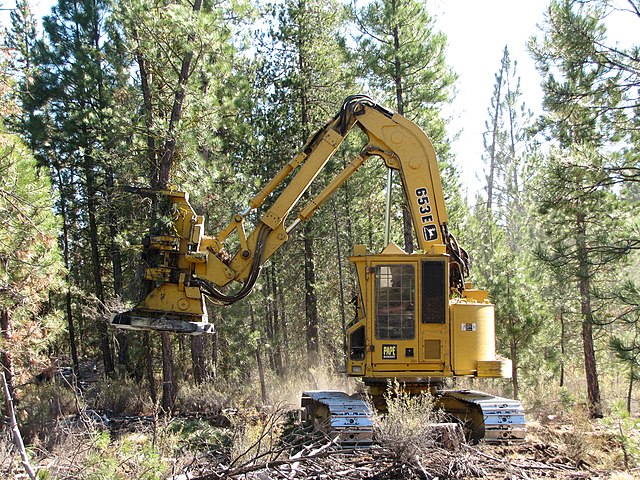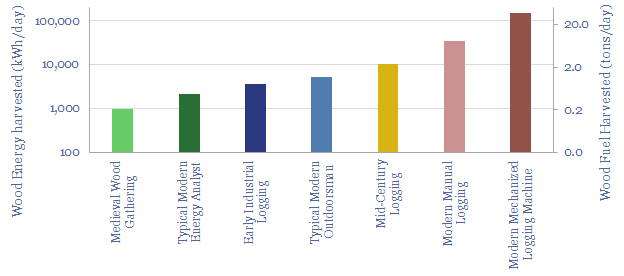This data-file estimates how much wood can be cut in a day, using back-of-the-envelope calculations, across 500-years of industrial history. In medieval times, a manorial tenant might have gathered 250kg of fallen branches in a good day, containing 1,000 kWh of thermal energy. A modern feller-buncher is 150x more productive. But a modern energy analyst is little better than a medieval peasant. Harvesting wood as a heating fuel is expensive, inconvenient and prone to risks.
Wood as a heating fuel: volume, mass and energy?
Wood fuel quantities are most commonly measured in cords. One cord is defined as 128 cubic feet of wood, which can be visualized as a 4′ tall pile, over an 8′ x 4′ area. Mass and energy content will vary. But as an approximation, 1 cord of wood weighs 1.4 tons, and 1 ton of wood contains 4,000 kWh of thermal energy, which is materially less than other fuels.
500-years: how much wood can be cut in a day?
Wood was the dominant heating fuel of the medieval energy system. We think that a manorial tenant could have gathered 250kg of fallen branches on a good day, limited by the ability to carry only 20-25 kg on a single trip, and secondarily by an absence of comfortable footwear.
Mechanization offered a 2-4x productivity gain by the early industrial era, using handheld saws, axes, and horses to pull felled trees towards water-courses, where they could be floated downstream and processed (painting below from the 1890s).

By the mid-20th century, chainsaws and trucks offered 2-4x further productivity gains, so a professional logging crew could harvest 10,000 kWh of energy per person per day. About the same as 1.5 tons of a typical coal grade. Although debatably, it is less harmful to nature to burn a tree that has already been dead for 400M years than cut down a living one.
Today the logging industry is another 15x more productive again, using slightly terrifying machines such as feller-bunchers to fell, pluck and de-limb entire trees, before cutting them to length, and stacking them for transport. Specialist manufacturers include Tigercat, John Deere, Caterpillar. We are increasingly doing more work on sustainable forestry and screening nature-based CO2 removal projects.

Energy crisis: stocking up on heating fuel?
Somewhere in between the productivity of a medieval peasant and the modern forestry industry, a typical person today can likely collect 0.5-2.5 tons of firewood in an 8-hour day, containing about 2,000-10,000 kWh of useful energy. The precise number depends on the use of modern power tools, the type of wood, and the experience of the person.
Here I am illustrating the point below, after a stint working at a forest plot in Estonia. We cleared out some thicket from this land last year, and have now started the gruelling task of planting proper trees in the gaps. Last weekend, it took about 1.5-hours to gather these thinned branches, drag them across to the road-side, then chop them up using shears and an axe.

Energy metrics: can I do better than a medieval peasant?
(1) Energy quantities. In 1.5 hours, I gathered almost 100kg of wood, which might contain 400kWh of thermal energy. For comparison, a typical bath consumes 4kWh of thermal energy, so this is about “100 baths”. Overall, a typical household consumes 40-60kWh of heat energy per day in the winter. So if I wanted to meet my household’s heating needs by gathering firewood, trips like the one above would need to be a weekly occurrence.
(2) Energy return on energy investment of harvesting this woody debris is actually quite good. My fitness tracking app tells me I burned about 350 kilocalories while doing this back-breaking labor. Which translates into an EROEI of 100x, if the result is 400kWh of wood fuel. Although the EROEI falls to around 10x if we also include the gasoline consumed in driving out to my forest-plot and back (for comparisons, please see our EROEI datafile).
(3) Cost. Unfortunately, if a typical person values their weekend time at $35/hour, and manages to generate 300 kWh of net fuel per hour, then their implied energy cost from gathering firewood comes out to about 12 c/kWh. This is equivalent to paying $35/mcf for natural gas. This is not much cheaper than European natural gas in the 2020s. And debatably, you may also need to add the costs of buying forest land, garden equipment, a woodshed and obligatory Patagonia outdoor wear.
(4) Carbon credentials. The carbon credentials of different wood uses are evaluated in our note here. In this case, I am going to argue that the wood I gathered would simply be decomposing if it were not used up. However, there is clearly a limit to how much fallen debris or thinned material you can collect from a woodland before you are chopping-down older growth trees and contributing to deforestation (the largest single CO2 emissions source on the planet, and more than all the world’s passenger cars).
(5) Other drawbacks. A final conclusion from this exercise is that it is quite inconvenient to have to cut, transport and dry your own fuel; then kindle a fire; then clean up the ashes and air out the smell of smoke from the living room. Out in the forest, there were some slightly hair-raising moments involving the axe, which could have greatly impaired my beloved Excel keyboard shortcuts. And my wife was also quite cross about the state of the car.
Conclusions: better to use modern energy?
How much wood can be cut in a day? The data-file linked below contains our calculations for the tonnage and energy content that can be harvested across different forestry practices over the past 500-years. It is a reminder of the virtues of the modern energy system, if only we could get back to an energy surplus.
